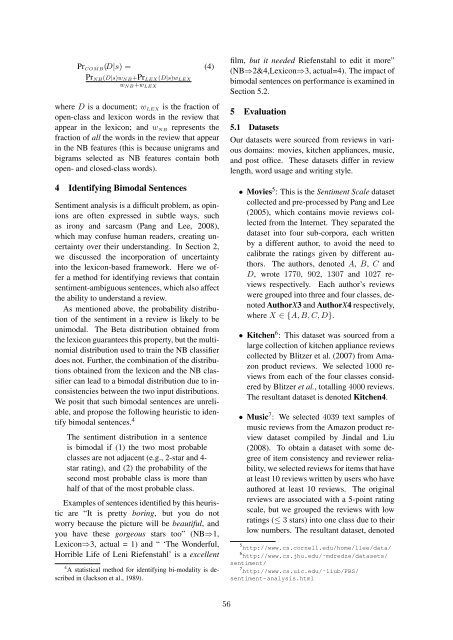Full proceedings volume - Australasian Language Technology ...
Full proceedings volume - Australasian Language Technology ...
Full proceedings volume - Australasian Language Technology ...
Create successful ePaper yourself
Turn your PDF publications into a flip-book with our unique Google optimized e-Paper software.
Pr COMB (D|s) = (4)<br />
Pr NB (D|s)w NB +Pr LEX (D|s)w LEX<br />
w NB +w LEX<br />
where D is a document; w LEX is the fraction of<br />
open-class and lexicon words in the review that<br />
appear in the lexicon; and w NB represents the<br />
fraction of all the words in the review that appear<br />
in the NB features (this is because unigrams and<br />
bigrams selected as NB features contain both<br />
open- and closed-class words).<br />
4 Identifying Bimodal Sentences<br />
Sentiment analysis is a difficult problem, as opinions<br />
are often expressed in subtle ways, such<br />
as irony and sarcasm (Pang and Lee, 2008),<br />
which may confuse human readers, creating uncertainty<br />
over their understanding. In Section 2,<br />
we discussed the incorporation of uncertainty<br />
into the lexicon-based framework. Here we offer<br />
a method for identifying reviews that contain<br />
sentiment-ambiguous sentences, which also affect<br />
the ability to understand a review.<br />
As mentioned above, the probability distribution<br />
of the sentiment in a review is likely to be<br />
unimodal. The Beta distribution obtained from<br />
the lexicon guarantees this property, but the multinomial<br />
distribution used to train the NB classifier<br />
does not. Further, the combination of the distributions<br />
obtained from the lexicon and the NB classifier<br />
can lead to a bimodal distribution due to inconsistencies<br />
between the two input distributions.<br />
We posit that such bimodal sentences are unreliable,<br />
and propose the following heuristic to identify<br />
bimodal sentences. 4<br />
The sentiment distribution in a sentence<br />
is bimodal if (1) the two most probable<br />
classes are not adjacent (e.g., 2-star and 4-<br />
star rating), and (2) the probability of the<br />
second most probable class is more than<br />
half of that of the most probable class.<br />
Examples of sentences identified by this heuristic<br />
are “It is pretty boring, but you do not<br />
worry because the picture will be beautiful, and<br />
you have these gorgeous stars too” (NB⇒1,<br />
Lexicon⇒3, actual = 1) and “ ‘The Wonderful,<br />
Horrible Life of Leni Riefenstahl’ is a excellent<br />
4 A statistical method for identifying bi-modality is described<br />
in (Jackson et al., 1989).<br />
film, but it needed Riefenstahl to edit it more”<br />
(NB⇒2&4,Lexicon⇒3, actual=4). The impact of<br />
bimodal sentences on performance is examined in<br />
Section 5.2.<br />
5 Evaluation<br />
5.1 Datasets<br />
Our datasets were sourced from reviews in various<br />
domains: movies, kitchen appliances, music,<br />
and post office. These datasets differ in review<br />
length, word usage and writing style.<br />
• Movies 5 : This is the Sentiment Scale dataset<br />
collected and pre-processed by Pang and Lee<br />
(2005), which contains movie reviews collected<br />
from the Internet. They separated the<br />
dataset into four sub-corpora, each written<br />
by a different author, to avoid the need to<br />
calibrate the ratings given by different authors.<br />
The authors, denoted A, B, C and<br />
D, wrote 1770, 902, 1307 and 1027 reviews<br />
respectively. Each author’s reviews<br />
were grouped into three and four classes, denoted<br />
AuthorX3 and AuthorX4 respectively,<br />
where X ∈ {A, B, C, D}.<br />
• Kitchen 6 : This dataset was sourced from a<br />
large collection of kitchen appliance reviews<br />
collected by Blitzer et al. (2007) from Amazon<br />
product reviews. We selected 1000 reviews<br />
from each of the four classes considered<br />
by Blitzer et al., totalling 4000 reviews.<br />
The resultant dataset is denoted Kitchen4.<br />
• Music 7 : We selected 4039 text samples of<br />
music reviews from the Amazon product review<br />
dataset compiled by Jindal and Liu<br />
(2008). To obtain a dataset with some degree<br />
of item consistency and reviewer reliability,<br />
we selected reviews for items that have<br />
at least 10 reviews written by users who have<br />
authored at least 10 reviews. The original<br />
reviews are associated with a 5-point rating<br />
scale, but we grouped the reviews with low<br />
ratings (≤ 3 stars) into one class due to their<br />
low numbers. The resultant dataset, denoted<br />
5 http://www.cs.cornell.edu/home/llee/data/<br />
6 http://www.cs.jhu.edu/˜mdredze/datasets/<br />
sentiment/<br />
7 http://www.cs.uic.edu/˜liub/FBS/<br />
sentiment-analysis.html<br />
56














